THE STRIKING PROCCESS |
|
Although hours of enjoyment can be had by those who enjoy the search, the fact that die errors don’t scream – “Look at me!” – prevents me from being an avid collector. I prefer my errors a little more “striking” which brings us to our final letter – “S” – which of course stands for striking. In fact, it was an off-center Lincoln Cent that first hooked me and got me started collecting errors.
All errors that occur during the striking process are lumped into this category – and there are many. Plus, there are differing opinions on what should be included among striking errors. Alan Herbert, in his book Official Guide to Mint Errors, lists all of the coins we looked at during our overview of planchet errors as striking errors. The typical listing goes something like “North Carolina quarter struck on a curved clip planchet.” His book only lists unstruck examples of the planchet errors we covered as true planchet errors. On the other hand, the ANA, in their correspondence course, lists them basically by which error came first. The planchet defect happened prior to striking (at least we hope or else we have a forgery on our hands!) thus it is classified as a planchet error. I subscribe to the ANA method.
I believe it is important to understand how the process is supposed to work when all goes as planned. So, to get a better understanding of how the design is struck into the coin, follow along on the three-dimensional cutaway pictured as we walk through the steps.
 Let’s begin just after a coin has been struck. The ejection cam rotates raising the anvil (obverse) die. The feeder then starts to push the freshly struck coin off to the right. At the same time a planchet in the second hole of the feeder is being brought to the striking position. As the cam continues to rotate the anvil die goes back down allowing this planchet to drop into the collar. The planchet is now in the striking chamber. With the anvil die now fully down the cam continues its cycle as the feeder is retracted. Once the feeder has cleared, the ram holding the hammer (reverse) die begins its downward stroke, under tremendous pressure, striking up the coin. As the cam continues its rotation the ram returns to its up position completing the cam’s 360° rotation and we are back where we started. Let’s begin just after a coin has been struck. The ejection cam rotates raising the anvil (obverse) die. The feeder then starts to push the freshly struck coin off to the right. At the same time a planchet in the second hole of the feeder is being brought to the striking position. As the cam continues to rotate the anvil die goes back down allowing this planchet to drop into the collar. The planchet is now in the striking chamber. With the anvil die now fully down the cam continues its cycle as the feeder is retracted. Once the feeder has cleared, the ram holding the hammer (reverse) die begins its downward stroke, under tremendous pressure, striking up the coin. As the cam continues its rotation the ram returns to its up position completing the cam’s 360° rotation and we are back where we started.
Other parts of the striking mechanism include the base plate which is rigid and
supports the anvil (obverse) die while the coin is being struck. The anvil die itself is free to move up and down in its recess in the base plate, but is keyed so it can not rotate. Conversely, the hammer (reverse) die is locked in the ram and can not move independent of the ram. It is here that the technician adjusts the alignment between the dies.
The last part of the striking mechanism shown is the floating collar or “third die.” It is the collar that keeps the planchet in place as it is struck; this impresses the reeding on the coin’s edge as the planchet expands. The collar is designed to float to protect the dies should a planchet fail to properly fall into the striking chamber.
|
|
DIE ADJUSTMENT STRIKE |
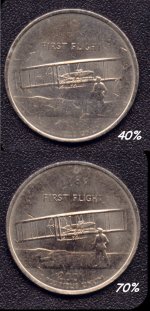
Click to Enlarge |
As stated above the die alignment is adjusted by the technician at the hammer or reverse die. Alignment is important in that the tolerances between the feeder fingers, the collar and the die are quite small such that too much initial offset could result in damage to any of the above. To avoid this, the technician runs trial strikes at reduced pressure to test his adjustments. The resultant coins are very weakly struck and are gathered up afterwards to be destroyed. Although intentionally made, any that escape the mint are considered errors and are called a “Die Adjustment Strike.” Shown here are two different examples – one showing approximately 40% detail and the second showing about 70% detail. The key diagnostic in identifying these is that there is equal weakness on all three sides – the reverse, the obverse and reeded edge. The Mint technicians are very careful to prevent these from escaping the Mint; however,
occasionally one will find its way out. |
|
STRUCK THROUGH GREASE |
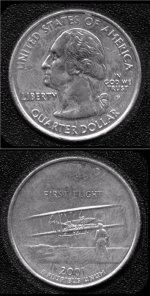
Click to Enlarge |
“Struck Through Grease” error at first glance looks very much like the Die Adjustment Strike. The diagnostics of this error is that the weakness is uneven and many times affects only one side of the coin. Furthermore, the reeding on these coins tends to be extremely sharp and well defined due to the increased pressure resulting from the hydraulic nature of the grease. The surface of the coin where the grease was also has a kind of hazy look which shows picture to the left. Although “Struck Through” errors can be due to any number of foreign objects entering the striking chamber, the most common are caused by grease. These are much more common than Die Adjustment Strike errors. |
|
STRUCK THROUGH METAL |
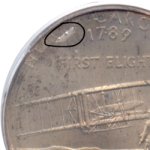
Click to Enlarge |
“Struck Trough” is a catch all phrase for any number of foreign material possibilities. Although I have not found any on North Carolina quarters yet, be on the lookout for any that appear to have been struck through cloth, struck through thread or struck through a bristle from a cleaning brush. I did have one fortuitous find on a North Carolina quarter I purchased as an example of another error that will be discussed in a later on this page. As I was examining the coin I noticed a small piece of what appears to be aluminum struck into the surface of the coin and is shown circled in the picture. I theorize that this is most likely a piece of an aluminum feeder finger that came in contact with the dies at some point and broke off. This event most likely jammed or damaged the feed mechanism leading to more problems. If it was not the root cause of the other error on the coin it is at least a hint at what might have
happened. |
|
PARTIAL COLLAR BROADSTRIKE |
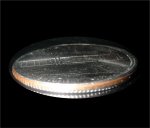
Click to Enlarge |
Broadstrikes can occur when the collar partially or fully sticks in the down position. When the collar partially sticks part of it is still exposed to the next planchet so when one examines the edge the reeding only goes partially across the coin as shown. Also, the portion where the reeding is missing tends to be of a slightly greater diameter since there was no collar to retain the metal expansion during the strike. If this were not enough there are two varieties of partial collar broadstrikes. The first is the “railroad rim” that derives its name from its resemblance to a wheel from a train. The reeding is straight and the unstruck portion forms a raised rim. The second is the tilted where as the name implies the collar and resulting effect are tilted or angled. On the North Carolina quarter of the 25 plus partial collar broadstrikes I have seen they have all been of the tilted variety. |
|
UNCENTERED BROADSTRIKE |

Click to Enlarge

Click to Enlarge |
When the collar fully sticks in the down position and none of the planchet contacts it the resulting quarter will have no reeding. If the full design appears on the coin, it too is called a “broadstrike.” As with the partial collar the full broadstrike can be further classified into two categories – centered and uncentered (not to be confused with the off-center discussed later). Also, since the collar is not there to check the expansion of the planchet a broadstruck coin will be of a larger diameter than a normal coin of the same denomination. This effect can be quite dramatic, especially on smaller denominations such as the cent and nickel. Of all the error types, uncentered broadstrikes are the most common North Carolina quarter error encountered. I stopped counting them as my census passed 100. It would not be impossible to build a roll of NC quarters with this error. |
|
MINOR OFF-CENTER |

Click to Enlarge |
As the design begins to “slide” off of the planchet or, said another way, is only partially struck on the planchet, the term used to describe the coin changes to “off-center.” The point at which a coin crosses the line between broadstrike and off-center is a bit blurry. By definition, to be off-center, the design must be partially missing on both sides of the coin. Unfortunately, in the area of statehood quarters, many just look at the state or “money” side of the coin in order to charge the premium for an off-center. Compare the two coins pictured above and you will see the subtle difference between the two types. The looseness in which many use the term off-center made making my unofficial census of both broadstrikes and minor off-centers very difficult. As there were many coins that could have gone either way, I tended to lump them together. That being said, I still counted over 50 that were true off-centers in the 5 to 20% range which I clasify as minor with most at the lower end of the scale. |
|
MAJOR OFF-CENTER |

Click to Enlarge |
Off-centers are described by the percentage of blank planchet present and the clock direction the design is going. Major off-center North Carolina quarters (greater than 20%) do not exist or so I was told by every dealer I talked to. They stated that with the tightening of security and quality control at the US Mint, the New York quarter (which preceded the North Carolina) was the last to be found with major off-centers. Discouraged but not deterred I continued my search and one day there it was an unbelievable raw 40% off-center North Carolina quarter on eBay.
Being the eBay sniper that I am, I sat and watched as the auction ticked to a close with my heart pounding, brow sweating and index finger trembling on the ENTER key ready to pounce at the last second. Thoughts of “I have to have this coin!” and “I am not going to be denied!” were swirling through my head. I decided that if I was going to lose, the winner was going to have to pay and pay dearly! So, I entered a “sizable” bid and waited for the final seconds to count down. Click! Wait ...…… I won! Fortunately for me, the final price was well under what I had entered with my last second bid. And as the rush of the auction subsided and normalcy slow returned this episode had me questioning my own sanity! Talk about being willing to spend “stupid” money on a coin – I was there on this one, but to this day it remains the only one I or any of my dealer friends have seen. I have no regrets – think no I know I would have had I lost that
auction.
|
|
MULTIPLE STRUCK ERRORS
The most commonly seen of these scarce errors is the traditional multiple struck coin where the first strike is normal and each subsequent strike is off-center. |
|
DOUBLE STRUCK
(FIRST STRIKE CENTERED) |

Click to Enlarge |
The mental picture most everyone gets when the discussion turns to multiple struck coins is the double struck example seen featured here. This coin is one of a dozen that I have encountered during the quest, but is the only “movie star” of the bunch. I purchased the coin, nicknamed “The Two Wilburs,” based on its description only — it was unavailable for viewing because it was on loan to the Discovery Channel for possible inclusion in one of their upcoming programs on the United States Mint. Once they were through with the coin it was shipped to its movie star retirement home back here in North Carolina where it now tours with its oddball cousins in the “Wanted a Few Oddball North Carolinians” exhibit. Well, we (me and the coin) waited and waited for its debut on
national television and then there it was in all its glory — obverse side only! What a disappointment, obviously these people had not heard of the concept of the “money side.” |
|
TRIPLE STRUCK |

Click to Enlarge |
Triple struck coins are also known for the North Carolina statehood quarter. The triple struck featured here might look familiar to you as it was used to illustrate the “Struck Through Metal” error a few examples up. It is one of seven triple strikes encountered during the quest. However, if one takes into count its second claim to error fame (aluminum struck in) it may well be unique. |
|
QUAD STRUCK |
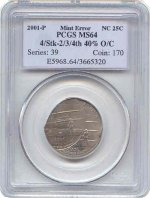
Click to Enlarge |
Quad struck coins are also known for the North Carolina statehood quarter. The dramatic quad strike featured here is one of only five I have encountered on the quest. To date, I have not seen a North Carolina statehood quarter with more than four strikes. |
|
DOUBLE STRUCK
(BOTH STRIKES OFF-CENTER) |

Click to Enlarge |
Less commonly seen of these scarce errors is the multiple struck coin where the first strike was off-center and each subsequent strike is also off-center. The coin shown here is an example of this unusual combination where the first strike was 15% off-center and the second was 70%. To date this is the only example of a previously off-center struck North Carolina quarter struck again I have encountered.
This coin was added to the collection after the original exhibit completed its competitive tour. It was incorporated into the physical exhibit and shown for the first time (non-competitively) at the Raleigh Coin Club Show in June 2004. |
|
COMBINATION OF ERRORS |

Click to Enlarge |
Combinational errors do exist; however, are very scarce if not rare. Due to their odd shape, clipped planchets sometimes have trouble feeding properly into the striking chamber which can result in a striking error on top of the previous planchet error. One would normal be inclined to assume these combinations would be one-of-a-kind items but surprisingly, this 15% straight edge clipped planchet that was also broadstruck is one of two seen and noted during this quest. They were practically twins!
After much thought of how and where to exhibit these combinational errors, I decided that they should be exhibited under the PDS heading where the first error occurred which is how I organized the physical exhibit. However, for this e-exhibit it will be listed under both the Planchet and the Striking headings. |
|



